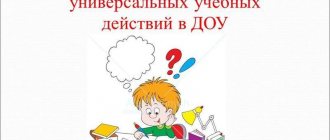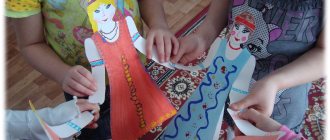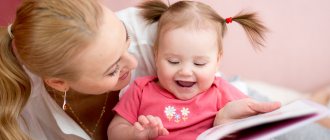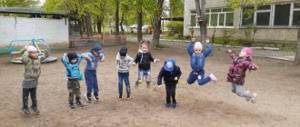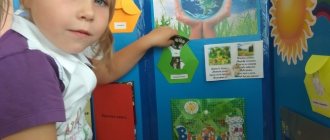Development of motor activity of preschool children in preschool educational institutions
Experience of a teacher in developing physical activity in children during the day (speech at the pedagogical council)
Today, in the preschool education system, special attention is paid to the health of children.
The health of children depends on a number of factors: biological, environmental, social and hygienic, as well as on the nature of pedagogical influence. Among the various factors influencing the health and performance of a growing organism is physical activity. Motor activity is a natural need for movement, the satisfaction of which is the most important condition for the comprehensive development and upbringing of a child. Only physical activity that is within the optimal range has a beneficial effect on the body. Thus, with physical inactivity (mode of inactivity), a number of negative consequences arise for the child: the functions and structures of a number of organs, the regulation of metabolism and energy are disrupted, and the body’s resistance to changing external conditions decreases. Hyperkinesia (excessively high physical activity) also violates the principle of optimal physical activity, which can lead to overstrain of the cardiovascular system and adversely affect the development of the child’s body. Therefore, our kindergarten provides a rational level of motor activity, which is achieved by improving the motor regime, since motor activity is determined not so much by the child’s biological need for movement, but by social factors : the organization of the pedagogical process, environmental conditions, upbringing and training. The motor activity of a preschooler must be purposeful and correspond to his experience, interests, desires, and functional capabilities of the body, which forms the basis of an individual approach to each child. Therefore, preschool teachers take care of the organization of motor activity, its diversity, as well as the fulfillment of the main tasks and requirements for its content. The content side of the motor regime should be aimed at developing the mental, spiritual and physical abilities of children. Therefore, when distributing the motor mode, we take into account: - the peculiarity of the preschool educational institution (preschool educational institution mode) - the individual characteristics of children, their age - health status - a differentiated approach All this helps to optimize the motor activity of children. The motor mode of our preschool educational institution includes all the dynamic activities of children, both organized and independent. The sanitary and epidemiological rules and regulations from the Russian Ministry of Health say that the volume of physical activity of pupils aged 3–7 years in organized forms of health-improving and educational activities should be provided for up to 6–8 hours a week, taking into account the psychophysiological characteristics of children, the time of year and the operating mode of the preschool educational institution. The motor mode model for preschool children consists of several blocks. 1. Physical education and health activities. 2. Training sessions. 3. Independent studies. 4. Physical education classes. 5. Additional classes. 6. Joint physical education and health work of the preschool educational institution and the family. The content and structure of preschool education classes is different, each of them, to one degree or another, has its own specific purpose. Morning exercises , exercises after a nap, walks to other areas of the garden, outdoor games and physical exercises while walking perform organizational and health-improving tasks. Physical exercises relieve fatigue in children and increase their mental performance. In classes, children learn, acquire the necessary skills, abilities, and knowledge. Health week, physical education, sports festivals are active recreation. Corrective gymnastics is intended for children with poor health. Depending on the purpose, all of the above types of activities and their nature change and are repeated at different intervals throughout the day, week, month, year, making up the health-improving motor regimen of preschoolers. Attaching particular importance to the role of physical activity in promoting the health of preschool children, we determine priorities in the daily routine. The first place in the motor regimen of the day belongs to physical education and health activities. These include well-known types of physical activity: morning exercises, outdoor games and physical exercises during walks, physical exercises in classes with mental stress, etc. In order to optimize physical activity and harden children in the practice of preschool educational institutions, we introduce additional physical activities related to a set of hardening measures, and also introduce non-traditional forms and methods of their implementation. Such activities include: healthy running in the air, jogging along massage paths in combination with air baths, gymnastics after naps, individual work with children on the development of movements and regulation of motor activity of children on an evening walk, walks - hikes in the forest, corrective gymnastics. The second place in the motor mode of children is occupied by physical education classes - as the main form of teaching motor skills and developing optimal motor activity in children. GCDs are held three times a week in the morning, two in the hall and one on the street. The third place is given to independent motor activity that occurs on the initiative of children. It gives wide scope for the manifestation of their individual motor capabilities. Independent activity is an important source of activity and self-development of a child. Its duration depends on the individual manifestations of children in motor activity, and therefore pedagogical guidance of independent activity is built taking into account the level of motor activity. Along with the listed types of physical education classes, active recreation and physical education and mass events are of no small importance in our preschool educational institution. These include a health week, physical education leisure, outdoor physical education and sports events, games and competitions, and sports competitions. The motor regime of older preschoolers also includes extra-group extracurricular activities (general physical training groups, clubs for various types of physical and sports exercises and games, dancing) and joint physical education and recreational work of the kindergarten and family (homework, physical education classes for children together with their parents , participation of parents in physical education and recreational public events of the preschool institution). The types of physical education classes described above, complementing and enriching each other, collectively provide the necessary physical activity for each child during the entire time he is in a preschool institution. It should be remembered that physical activity is optimal when its main parameters (volume, duration, intensity) correspond to the individual data of physical development and motor readiness of children, also when it is ensured in compliance with environmental conditions - natural, objective, social, rules alternating tension and rest, gradually increasing physical activity.
We recommend watching:
Learning to play basketball in the context of cooperation between educational institutions of various types Do-it-yourself sports equipment for a kindergarten Decorating a kindergarten site in winter Do-it-yourself physical education equipment for a kindergarten
Similar articles:
Features of the development of preschool children
